
Beetles are insects that form the order Coleoptera, in the superorder Holometabola. Their front pair of wings are hardened into wing-cases, elytra, distinguishing them from most other insects. The Coleoptera, with about 400,000 described species, is the largest of all orders, constituting almost 40% of described insects and 25% of all known animal species; new species are discovered frequently, with estimates suggesting that there are between 0.9 and 2.1 million total species. However, the number of beetle species is challenged by the number of species in dipterans (flies) and hymenopterans (wasps).

Stag beetles comprise the family Lucanidae. It has about 1,200 species of beetles in four subfamilies. Some species grow to over 12 centimetres, but most to about 5 cm (2 in).
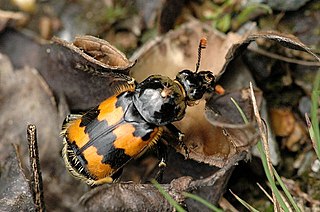
Silphidae is a family of beetles that are known commonly as large carrion beetles, carrion beetles or burying beetles. There are two subfamilies: Silphinae and Nicrophorinae. Members of Nicrophorinae are sometimes known as burying beetles or sexton beetles. The number of species is relatively small, at around two hundred. They are more diverse in the temperate region although a few tropical endemics are known. Both subfamilies feed on decaying organic matter such as dead animals. The subfamilies differ in which uses parental care and which types of carcasses they prefer. Silphidae are considered to be of importance to forensic entomologists because when they are found on a decaying body they are used to help estimate a post-mortem interval.
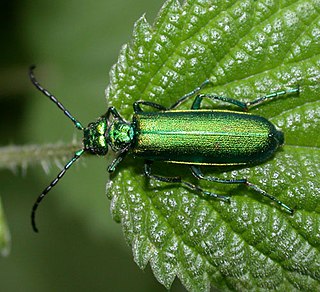
Lytta vesicatoria, also known as the Spanish fly, is an aposematic emerald-green beetle in the blister beetle family (Meloidae). It is distributed across Eurasia.
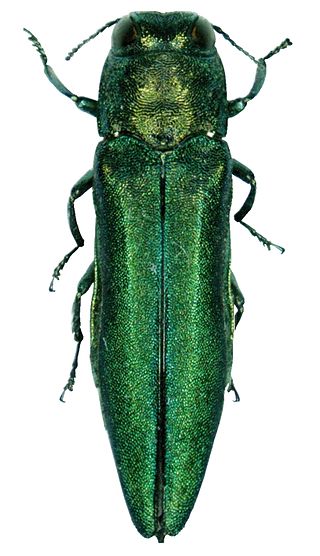
The emerald ash borer, also known by the acronym EAB, is a green buprestid or jewel beetle native to north-eastern Asia that feeds on ash species. Females lay eggs in bark crevices on ash trees, and larvae feed underneath the bark of ash trees to emerge as adults in one to two years. In its native range, it is typically found at low densities and does not cause significant damage to trees native to the area. Outside its native range, it is an invasive species and is highly destructive to ash trees native to Europe and North America. Before it was found in North America, very little was known about the emerald ash borer in its native range; this has resulted in much of the research on its biology being focused in North America. Local governments in North America are attempting to control it by monitoring its spread, diversifying tree species, and through the use of insecticides and biological control.
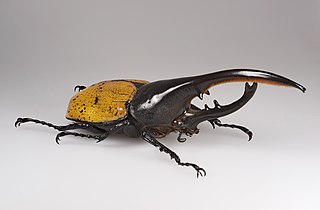
The Hercules beetle is a species of rhinoceros beetle native to the rainforests of southern Mexico, Central America, South America, and the Lesser Antilles. It is the longest extant species of beetle in the world, and is also one of the largest flying insects in the world.
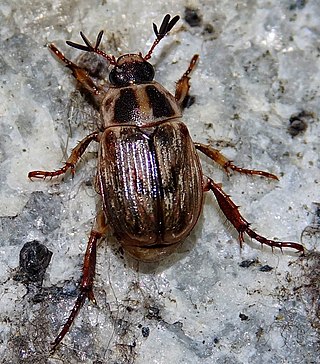
Anomala orientalis, also known as the oriental beetle (OB), is a species of Rutelinae in the family Scarabaeidae. It is a beetle about 0.7 - 1.1 cm long, with mottled, metallic brown- and black-colored elytra and a similarly colored thorax and head during the adult stage. It is sometimes confused with the larger and more colorful Japanese beetle. During the larval stage, the oriental beetle can be identified by the parallel line raster pattern.

Lucanus cervus, known as the European stag beetle, or the greater stag beetle, is one of the best-known species of stag beetle in Western Europe, and is the eponymous example of the genus. L. cervus is listed as Near Threatened by the IUCN Red List.

The chorus cicada, Amphipsalta zelandica, is the most common species of cicada in New Zealand, where it is endemic and found in most areas. They typically live in forests and areas with open bush, where their left-over nymph skins can be seen on tree trunks and branches during the summer months. The males produce their cicada sound in unison, which can reach deafening proportions at the height of their population around February. Groups of cicada can suddenly transition from the typical cicada sound to synchronised clicks, using their wings to clap against the surface they are sitting on.

The American carrion beetle is a North American beetle of the family Silphidae. It lays its eggs in, and its larvae consume, raw flesh and fungi. The larvae and adults also consume fly larvae and the larvae of other carrion beetles that compete for the same food sources as their larvae. They prefer to live in marshy and woody habitats. Necrophila americana emerge from their larval state in the early summer. A cuckoo bumble bee, Bombus ashtoni, displays close mimicry with the American carrion beetle. They are important in forensic studies because of their tendency to thrive on large carcasses.

Callipogon relictus is a species of longhorn beetle which is mostly found in Korea, but also in China and southern part of Russian Far East. It inhabits mixed and deciduous forests. The population of Callipogon relictus is decreasing due to deforestation and uncontrolled collection, and therefore the species are listed in the Russian Red Book.

Austroplatypus incompertus, a type of ambrosia beetle, is endemic to Australia. They are found in mesic forests, and subtropical and tropical ecosystems along the east coast of Australia. There are many unique characteristics attributable to the A. incompertus, like their gallery excavation in several Eucalyptus species, their obligate eusocial behavior, their relationship with fungi, and their unique sexual dimorphism. These beetles are one of the only insects that display obligate eusocial behavior. Additionally, their sexually dimorphic traits are of interest, since body size is reversed with males having smaller torsos than female A. incompertus beetles.

Rhipiceridae is a family of beetles found worldwide. The larva of rhipicerids are parasitoids of cicada nymphs. Rhipiceridae and Dascillidae form the super family Dascilloidea, within the Elateriformia.
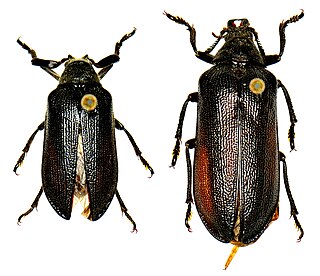
Sandalus is a genus of cicada parasite beetles in the family Rhipiceridae.
Sandalus californicus is a species of cicada parasite beetle in the family Rhipiceridae. It is found in North America.

Sandalus petrophya, the cedar beetle, is a species of cicada parasite beetle in the family Rhipiceridae. It is found in North America.
Meloe franciscanus is a species of blister beetle in the family Meloidae. It is found in the deserts of the southwestern United States. The larvae are parasites of bee larvae, eating them and consuming their provisions.

Dendroctonus adjunctus, the roundheaded pine beetle, is a species of bark beetle in the family Curculionidae found in North America. A parasite, the roundheaded pine beetle feeds on and eventually kills pine trees of several species in Guatemala, Mexico, and the Southern United States.
Sandalus porosus is a species of cicada parasite beetle in the family Rhipiceridae. It is found in North America.

Rhipicera is a genus of beetle belonging to the family Rhipiceridae. The larvae are parasitoids of cicadas.
















